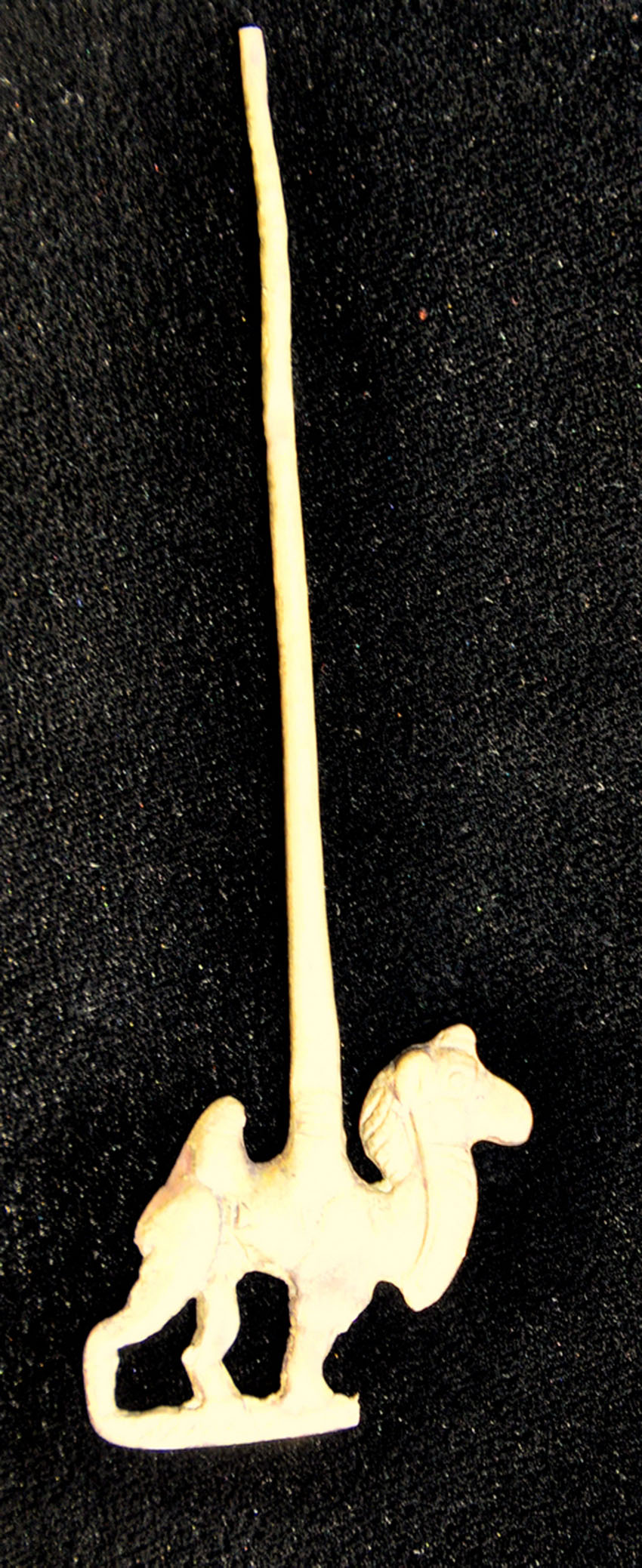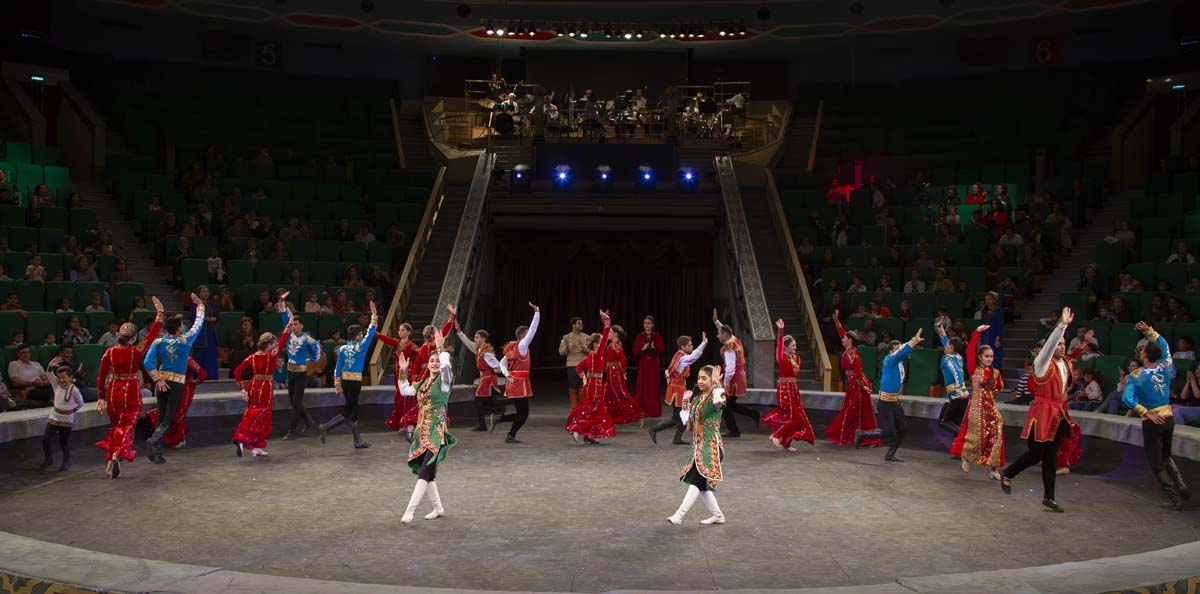Archaeological findings of ancient and great state of Margush represent special value among the exhibits of the Museum of Visual Arts. Every rarity has its own history covered by mystery, which are to be uncovered by the scientists. However, already now, some exhibits represent huge interest for art historians as artworks made by skilful Margush masters many millenniums ago.
There are well preserved silver cylindrical vessel among them, which was found in the secret compartment of one of the burial places and dated by the middle of 3000 BC. It can be easily referred to as a luxury item. The owner of the vessel much probably was prosperous aristocrat with a good taste. Outstanding archaeologist, Doctor of Historical Sciences, Honoured Academician of the Academy of Sciences of Turkmenistan Victor Sarianidi placed this unique finding in one row with the world’s art masterpieces.
Talented master portrayed the picture of the caravan of Bactrian camels, having conveyed character features of animals’ appearance. Good condition of the artefact allowing to appreciate highly artistic technique of embossing, gave start to historical dilemma.
Visual disproportion in the image of upper and lower parts of the body as well as obvious focus on haughty heads of the animals decorated with thick main hairs and their careless glance leave the feeling of static nature. Detailed raised embossing of the legs of the animals with strained muscles and tendons gives the dynamism to the composition. Do the camels stay or move? Was it intentional original thought of the jeweller or nobody paid special attention to such details 5 thousand years ago? There are more questions than answers today.
Portraying of the animals (animalism) on different craft production was very popular among ancient masters. And, it was not only decorative device. Seal rings, dishes, seals and other items with animalistic plots bore certain sacral message; they serve as talismans and charms.
There were some items, which highlighted not only its own status but also the one of the owner. It is important to mention that the vessel found during the excavations had triangle brand – the trademark of the master and the evidence of elitism of the item. Discovery of similar brand on tiny silver man cloak pin. It is also decorated with filigree picture of Bactrian camel. Margush jewellers were famous by their miniature items and this pin, distinguished by accuracy of anatomic proportions of the camel with clear picture of main hairs and eyes, is a bright evidence of it.
The question comes looking at these unique things, which reached us owing to research mission of the archaeologists, why the pin and the vessel are decorated by the picture of camel? Probably, the vessel had religious meaning, as the camel were the object of worshiping in the Bronze Age. It is indicated by one of the versions that states that the name of Zaratustra, the founder of Zoroastrianism, is translated as the owner of golden camel. In oriental mythology, the picture of camel symbolized the victory of goodness over the evilness. There is special role of camel in Islam as well, the Prophet Mohammed preached while sitting on the camel.
There are well preserved silver cylindrical vessel among them, which was found in the secret compartment of one of the burial places and dated by the middle of 3000 BC. It can be easily referred to as a luxury item. The owner of the vessel much probably was prosperous aristocrat with a good taste. Outstanding archaeologist, Doctor of Historical Sciences, Honoured Academician of the Academy of Sciences of Turkmenistan Victor Sarianidi placed this unique finding in one row with the world’s art masterpieces.
Talented master portrayed the picture of the caravan of Bactrian camels, having conveyed character features of animals’ appearance. Good condition of the artefact allowing to appreciate highly artistic technique of embossing, gave start to historical dilemma.
Visual disproportion in the image of upper and lower parts of the body as well as obvious focus on haughty heads of the animals decorated with thick main hairs and their careless glance leave the feeling of static nature. Detailed raised embossing of the legs of the animals with strained muscles and tendons gives the dynamism to the composition. Do the camels stay or move? Was it intentional original thought of the jeweller or nobody paid special attention to such details 5 thousand years ago? There are more questions than answers today.
Portraying of the animals (animalism) on different craft production was very popular among ancient masters. And, it was not only decorative device. Seal rings, dishes, seals and other items with animalistic plots bore certain sacral message; they serve as talismans and charms.
There were some items, which highlighted not only its own status but also the one of the owner. It is important to mention that the vessel found during the excavations had triangle brand – the trademark of the master and the evidence of elitism of the item. Discovery of similar brand on tiny silver man cloak pin. It is also decorated with filigree picture of Bactrian camel. Margush jewellers were famous by their miniature items and this pin, distinguished by accuracy of anatomic proportions of the camel with clear picture of main hairs and eyes, is a bright evidence of it.
The question comes looking at these unique things, which reached us owing to research mission of the archaeologists, why the pin and the vessel are decorated by the picture of camel? Probably, the vessel had religious meaning, as the camel were the object of worshiping in the Bronze Age. It is indicated by one of the versions that states that the name of Zaratustra, the founder of Zoroastrianism, is translated as the owner of golden camel. In oriental mythology, the picture of camel symbolized the victory of goodness over the evilness. There is special role of camel in Islam as well, the Prophet Mohammed preached while sitting on the camel.







